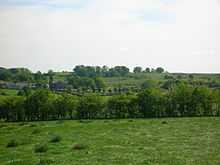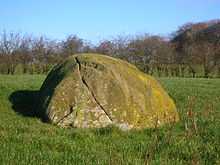Thurgartstone
The Thurgatstane or Ogrestane is a famous stone near Dunlop in East Ayrshire in Scotland. The Thurgatsane is thought to have been a rocking stone at one time, but it no longer rocks.

Name
The Thurgartstane or Ogrestane, or in modern English, the Thurgartstone or Ogrestone, is also known as the Thorgatstane, the Field Spirit Stane, T'Ogra Stane, Thugart Stane, Ogirtstane, Fiend's Stane, Ogart Stane, Horgar Stane or Thougritstane.
One explanation of the name is that it derives from 'Thor's Great Stone'. Another is that the name comes from the phrase "Thou Great Stone" or just '"grit stane" (Paterson 1866). The term 'The Stone of the Ogre' may indicate some forgotten legend. Some names may be spelling errors originating in or propagated by the Ordnance Survey or other maps. Another theory is that the name is derived from the word "Tagairtstane", which means "the priest's stone."
Location

The Thurgartstone is close to Dunlop on the Lugton Road is Black Burn Valley. In the middle of a field near the Chapel Crags is the Thurgatstane or Ogrestane. Dunlop or Boarland Hill, the site of Dunlop Castle once held by the De Ross family, can be seen from the stone.
The stone is in a sheltered spot, with ample running water. It is somewhat hidden from view.
Description
The Thurgartston is a "glacial erratic stone". It is composed of blue augitic porphyrite. This rock is different than the 'native' stone of the area. The Thurgartston weighs about 25 tons and the part above ground is about twelve feet by eight feet (Bayne 1935). It is set near the site of the pre-Reformation St. Mary's Chapel.
The site is listed and protected by Historic Scotland.
Monastic settlement

There was a monastic settlement associated with the chapel of Saint Mary near the Thurgartstone site. The history of the site is apparently similar to the history of the Chapel Hill site at Chapeltoun.
There are steps cut into the rock that led up to the monk's cemetery. The monastery, original chapel and graveyard are no longer visible. There is a holy well in the "field bordered by the burn." The new buildings called "Marys Chapel" at the site are built on the foundation of the original chapel. Chapelhouse Farm nearby was once called Brandlecraig.[1]
Associated Beliefs
The Thurgartstone has long been associated with pagan ritual practices. There are still May Day celebrations and events at the site.
This 'Druidical' stone is thought by some to have been a 'rocking or logan' stone at one time. It is now firmly set in the 'rubbish' and dirt.[2]
There are records showing that "even as late as the time of Popery", Catholics would do penance by crawling on their knees around this stone, crying "O thou grit stane". Apparently they held a belief that the Deity was present in the Thurgartstone (MacIntosh 1894).
Farmers from Brandleside Farm did not remove the stone. They also kept their ploughs a set distance away from the Thurgartstone. This was presumably because legend has it that there were pagan burials around this monument (Paterson 1866).
The ancient Dunlop Carlin stone is on the other side of the village.
Views of the Thurgarstone in 2007
-
North Side.
-
Dunlop Village in the background.
-
-
Viewed from above.
-
Viewed from above.
-
-
Viewed from the slope which runs down to the road.
-
Dunlop Castle hill from the top of the stone.
See also
- Rocking Stones
- Corsehill, Lainshaw, Robertland and Dunlop
- Stones of Scotland
- Corsehill
References
- Bayne, John F. (1935). Dunlop Parish - A History of Church, Parish, and Nobility. Pub. T.& A. Constable, Pps. 10 - 16.
- MacIntosh, John (1894). Ayrshire Nights Entertainments: A Descriptive Guide to the History, Traditions, Antiquities, etc. of the County of Ayr. Pub. Kilmarnock. P. 195.
- Paterson, James (1866). History of the Counties of Ayr and Wigton. Pub. Edinburgh.
External links
- Thurgatstane Photo
- 's_Guide_to_Local_History_Terminology A Researcher's Guide to Local History terminology
Coordinates: 55°43′9.6″N 4°32′22.8″W / 55.719333°N 4.539667°W







